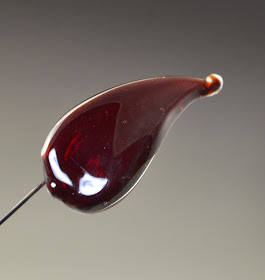CiM Garnet - a very, very rich dark red. I, frankly, had some problems with this one - although I see from the CiM site that it might well have been from not heating it enough to start. Ha - me working too cool, who would have thunk it?
In all fairness - I made no effort to strike this, as red generally strikes as you work it, and I often like the slightly unstruck fire opal orange edges.
However - this glass seems to develop a greyish streakiness that does not go away by itself.
First off - the rod. This is a very dark, very dense red. Garnet usually is.
This looks quite orangey - but is strongly side-lit. You can definitely see where it has developed colour unevenly though.
Same piece, backlit.
and just regular light.
This one, I encased. It had grey streaks when I encased it, and they did not go away. I expected them too.
Maybe I'm being overly picky, it is definitely red - but not a sparkling juicy red.
Very strong side-light.
And again, on the other side. Maybe you can actually plan for this and use it to good advantage.
Two curly doo-dads - (I am currently taking a break from bead-cleaning) - encased in clear - three different lightings. If nothing else - this shows you what a difference the light can make.
And the same three approaches to some leafy bits.
And a banner. Here - where the glass is thin - it really shines as a colour.
And this one I rather like. Again - thin enough to really show the colour.
Unfortunately - you can see some cracking in the glass around the wire.
Still - I like this piece.
Garnet - I would suggest trying the heat-to-clear approach with this, and make a point of striking it instead of leaving it to strike in the kiln or just as you work it. It's very dark and may be daunting to the beginner.
Round 2
I decided that with that little stumpy end, I wanted to see what happened if I melted it clear - got it so hot that it went clear. And this is the lovely little jewel that resulted. I got it drippy hot, completely clear, wound off the bead, and watched it cool and go red before my eyes without striking. And popped it in the kiln. Beautiful!
And with the tiny bit I had left - you just can't get it that hot and put it on the wire - the wire won't handle that kind of heat - due to being that much thinner. I encased it, and pulled it - which cools it quite quickly. I got some grey streaks and this time - spent rather a lot of time trying to re-heat them and strike them out. Fortunately, that reduced them significantly - although I won't say they are completely gone.
Same leaf - stronger light.
And here is the leaf and the bead together. A very dramatic difference in colour.
Not sure what to make of all this. Definitely a glass that can challenge you. The spacer bead is gorgeous, in other applications - you are going to get different results.
 CiM Prairie Grass is an opaque, light green that is just slightly less yellowish than Effetre's 212 Pea Green. The saturation and shade is almost identical, but the hue is slightly different.
CiM Prairie Grass is an opaque, light green that is just slightly less yellowish than Effetre's 212 Pea Green. The saturation and shade is almost identical, but the hue is slightly different. 






















































